Abstract
One hundred consecutive patients treated with epsilon aminocaproic acid 24 grams daily prior to surgery for ruptured intracranial aneurysms have been compared with the previous 100 patients managed similarly but without anti-fibrinolytic drugs. No other alterations in management were made and the two series are closely comparable in all other respects. Fewer episodes of recurrent haemorrhage and deaths from this cause occurred in the treated patients, but more cases of cerebral ischaemia occurred. Neither difference is statistically significant and overall more deaths occurred in the patients treated with antifibrinolytic drugs. The value of this method of treatment in the management of aneurysmal subarachnoid haemorrhage is questioned.
Full text
PDF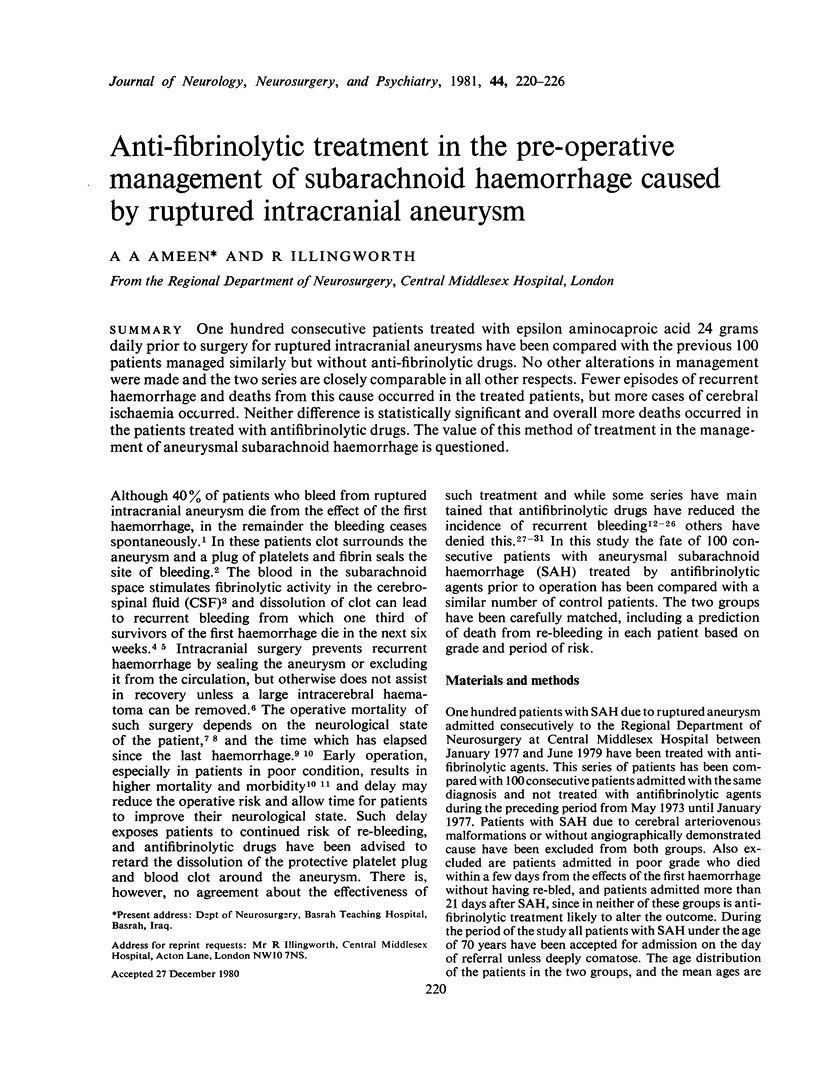
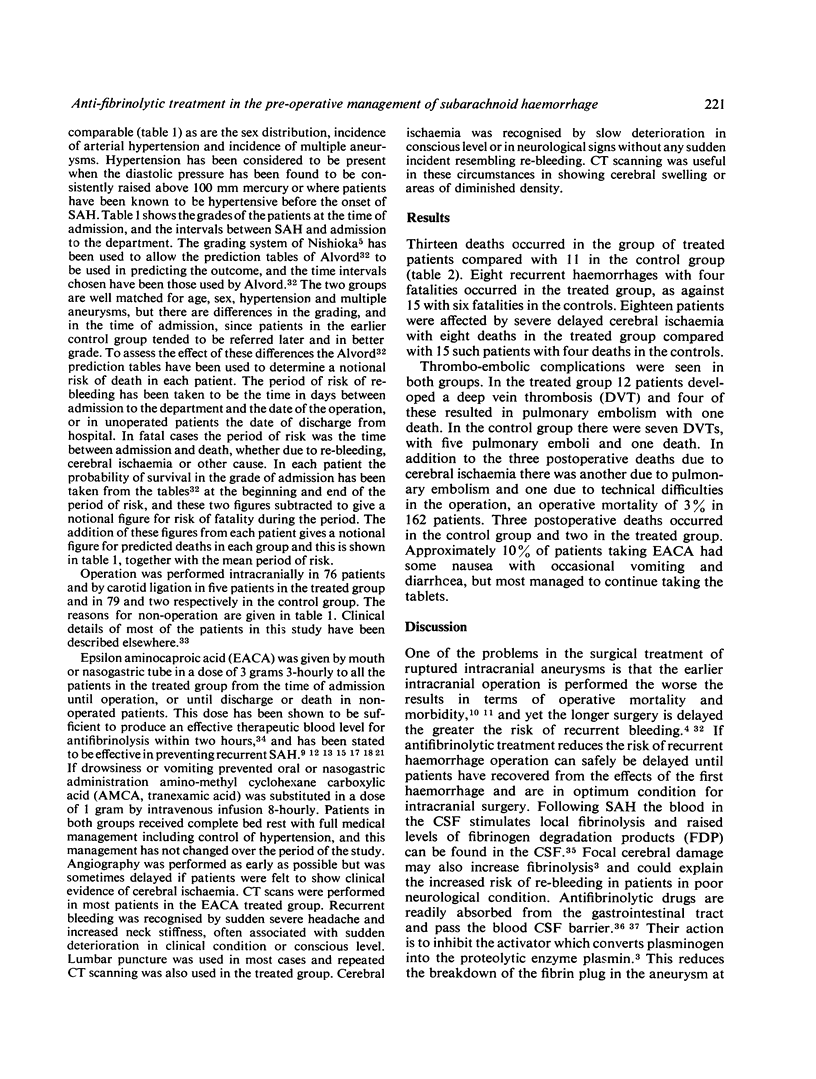
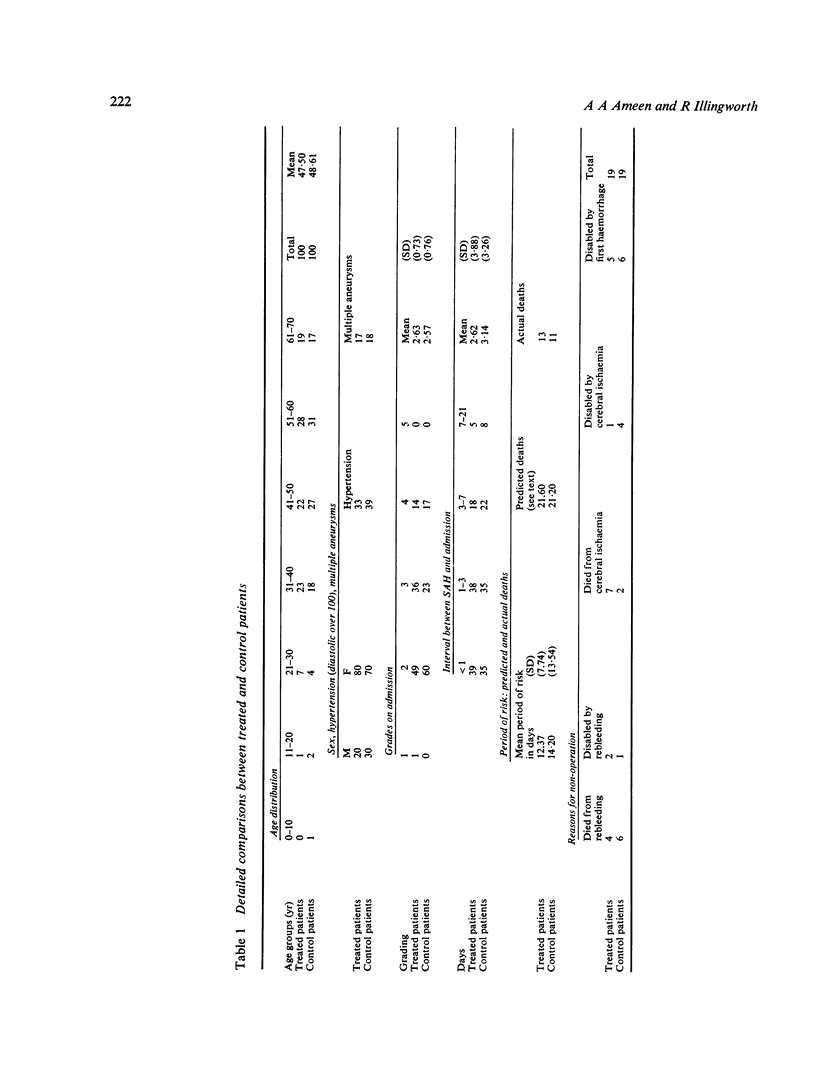
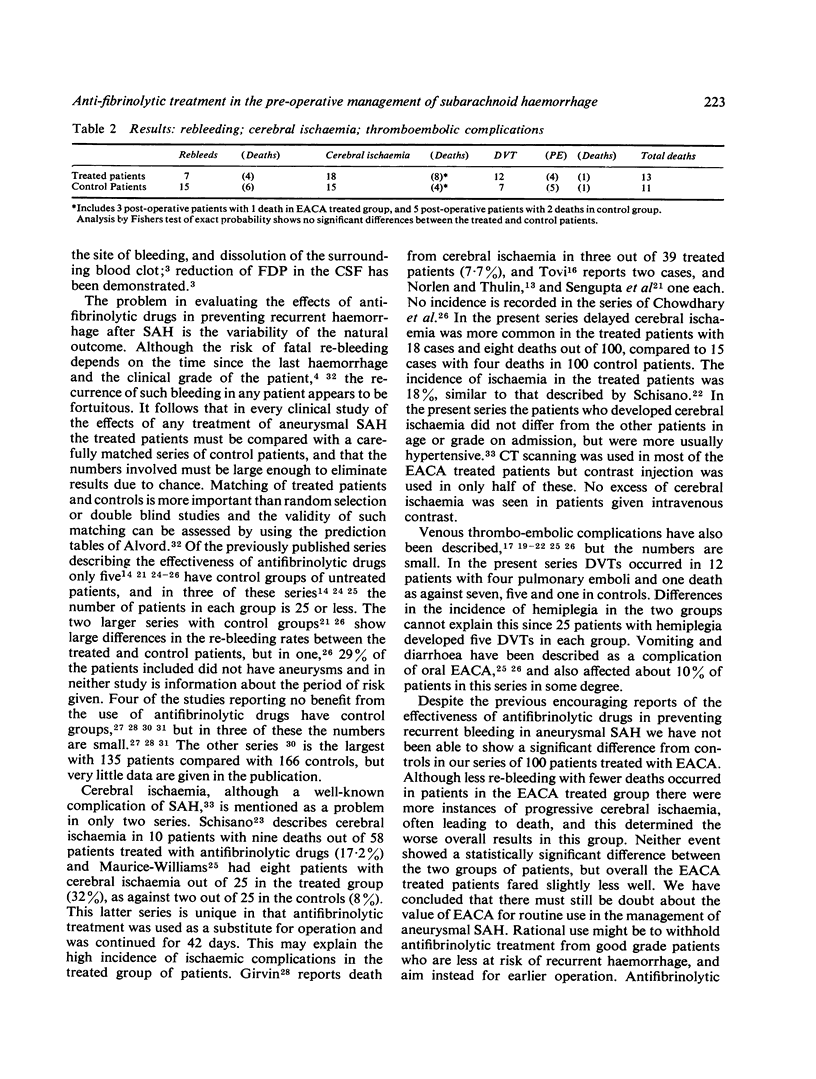
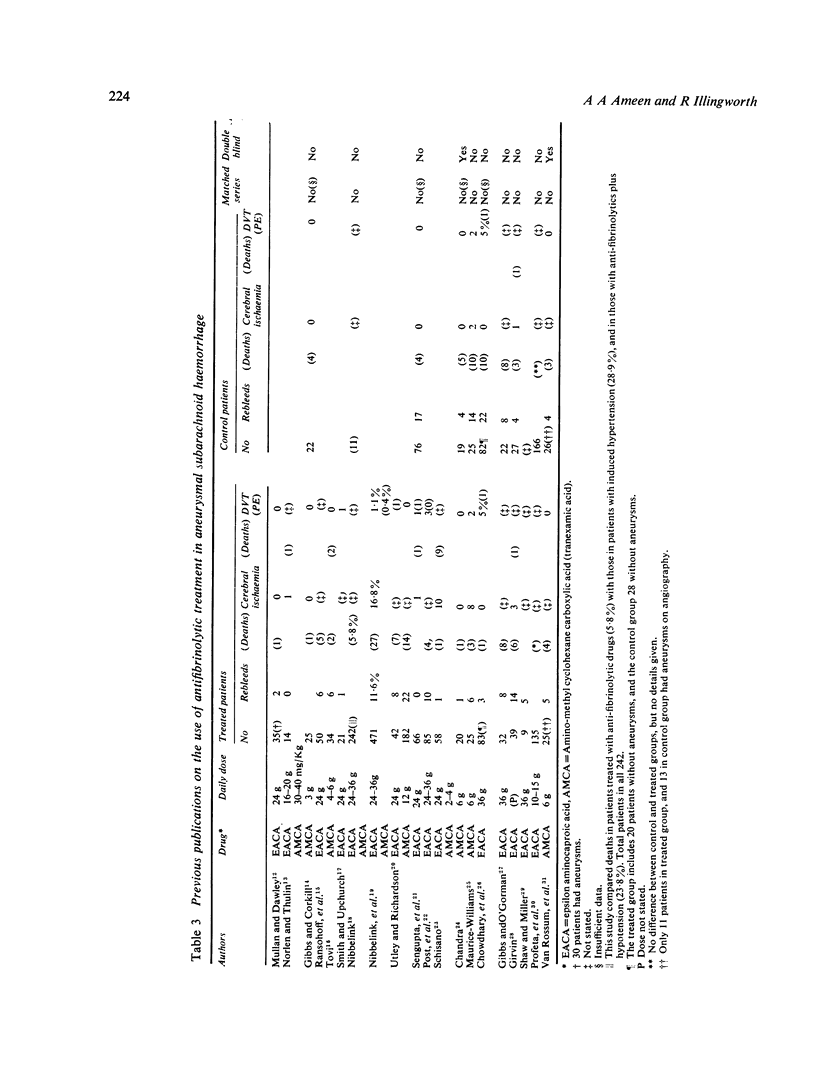
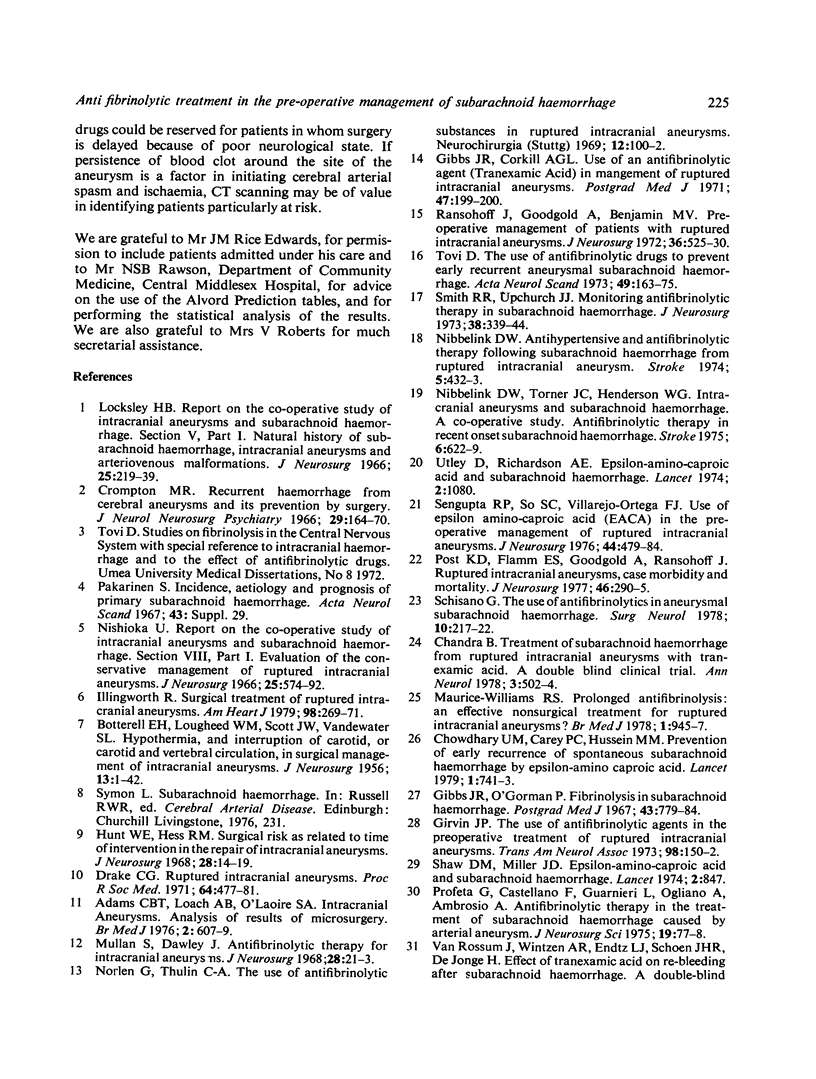
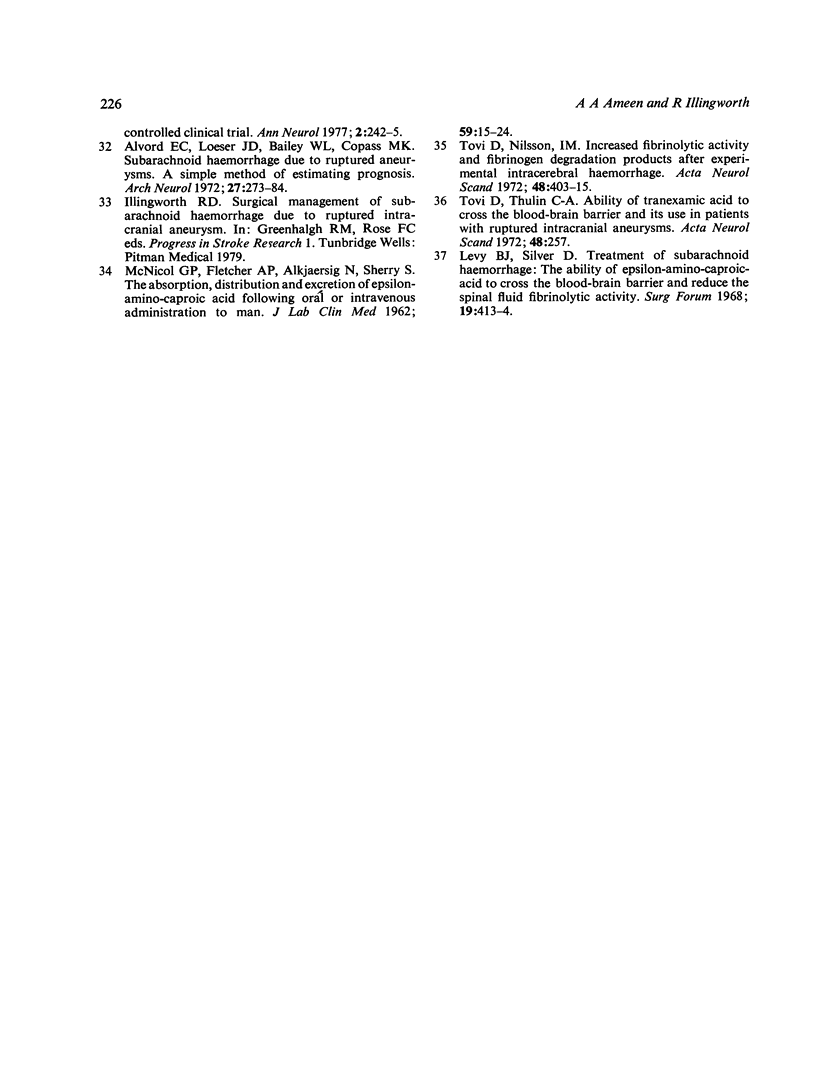
Selected References
These references are in PubMed. This may not be the complete list of references from this article.
- Adams C. B., Loach A. B., O'laoire S. A. Intracranial aneurysms: analysis of results of microneurosurgery. Br Med J. 1976 Sep 11;2(6036):607–609. doi: 10.1136/bmj.2.6036.607. [DOI] [PMC free article] [PubMed] [Google Scholar]
- Alvord E. C., Jr, Loeser J. D., Bailey W. L., Copass M. K. Subarachnoid hemorrhage due to ruptured aneurysms. A simple method of estimating prognosis. Arch Neurol. 1972 Oct;27(4):273–284. doi: 10.1001/archneur.1972.00490160001001. [DOI] [PubMed] [Google Scholar]
- BOTTERELL E. H., LOUGHEED W. M., SCOTT J. W., VANDEWATER S. L. Hypothermia, and interruption of carotid, or carotid and vertebral circulation, in the surgical management of intracranial aneurysms. J Neurosurg. 1956 Jan;13(1):1–42. doi: 10.3171/jns.1956.13.1.0001. [DOI] [PubMed] [Google Scholar]
- Chandra B. Treatment of subarachnoid hemorrhage from ruptured intracranial aneurysm with tranexamic acid: a double-blind clinical trial. Ann Neurol. 1978 Jun;3(6):502–504. doi: 10.1002/ana.410030607. [DOI] [PubMed] [Google Scholar]
- Chowdhary U. M., Carey P. C., Hussein M. M. Prevention of early recurrence of spontaneous subarachnoid haemorrhage by epsilon-aminocaproic acid. Lancet. 1979 Apr 7;1(8119):741–743. doi: 10.1016/s0140-6736(79)91204-2. [DOI] [PubMed] [Google Scholar]
- Drake C. G. Ruptured intracranial aneurysms. Proc R Soc Med. 1971 May;64(5):477–481. [PMC free article] [PubMed] [Google Scholar]
- Gibbs J. R., Corkill A. G. Use of an anti-fibrinolytic agent (tranexamic acid) in the management of ruptured intracranial aneurysms. Postgrad Med J. 1971 Apr;47(546):199–200. doi: 10.1136/pgmj.47.546.199. [DOI] [PMC free article] [PubMed] [Google Scholar]
- Gibbs J. R., O'Gorman P. Fibrinolysis in subarachnoid haemorrhage. Postgrad Med J. 1967 Dec;43(506):779–784. doi: 10.1136/pgmj.43.506.779. [DOI] [PMC free article] [PubMed] [Google Scholar]
- Girvin J. P. The use of antifibrinolytic agents in the preoperative treatment of ruptured intracranial aneurysms. Trans Am Neurol Assoc. 1973;98:150–152. [PubMed] [Google Scholar]
- Hunt W. E., Hess R. M. Surgical risk as related to time of intervention in the repair of intracranial aneurysms. J Neurosurg. 1968 Jan;28(1):14–20. doi: 10.3171/jns.1968.28.1.0014. [DOI] [PubMed] [Google Scholar]
- Illingworth R. Surgical treatment of ruptured intracranial aneurysms. Am Heart J. 1979 Aug;98(2):269–271. doi: 10.1016/0002-8703(79)90232-1. [DOI] [PubMed] [Google Scholar]
- Levy B. J., Silver D. Treatment of subarachnoid hemorrhage: the ability of epsilon aminocaproic acid to cross the blood brain barrier and reduce the spinal fluid fibrinolytic activity. Surg Forum. 1968;19:413–414. [PubMed] [Google Scholar]
- Locksley H. B. Natural history of subarachnoid hemorrhage, intracranial aneurysms and arteriovenous malformations. Based on 6368 cases in the cooperative study. J Neurosurg. 1966 Aug;25(2):219–239. doi: 10.3171/jns.1966.25.2.0219. [DOI] [PubMed] [Google Scholar]
- Maurice-Williams R. S. Prolonged antifibrinolysis: an effective non-surgical treatment for ruptured intracranial aneurysms? Br Med J. 1978 Apr 15;1(6118):945–947. doi: 10.1136/bmj.1.6118.945. [DOI] [PMC free article] [PubMed] [Google Scholar]
- Mullan S., Dawley J. Antifibrinolytic therapy for intracranial aneurysms. J Neurosurg. 1968 Jan;28(1):21–23. doi: 10.3171/jns.1968.28.1.0021. [DOI] [PubMed] [Google Scholar]
- Nibbelink D. W., Torner J. C., Henderson W. G. Intracranial aneurysms and subarachnoid hemorrhage. A cooperative study. Antifibrinolytic therapy in recent onset subarachnoid hemorrhage. Stroke. 1975 Nov-Dec;6(6):622–629. doi: 10.1161/01.str.6.6.622. [DOI] [PubMed] [Google Scholar]
- Nishioka H. Report on the cooperative study of intracranial aneurysms and subarachnoid hemorrhage. Section VII. I. Evaluation of the conservative management of ruptured intracranial aneurysms. J Neurosurg. 1966 Nov;25(5):574–592. doi: 10.3171/jns.1966.25.5.0574. [DOI] [PubMed] [Google Scholar]
- Norlén G., Thulin C. A. The use of antifibrinolytic substances in ruptured intracranial aneurysms. Neurochirurgia (Stuttg) 1969 May;12(3):100–102. doi: 10.1055/s-0028-1095290. [DOI] [PubMed] [Google Scholar]
- Post K. D., Flamm E. S., Goodgold A., Ransohoff J. Ruptured intracranial aneurysms. Case morbidity and mortality. J Neurosurg. 1977 Mar;46(3):290–295. doi: 10.3171/jns.1977.46.3.0290. [DOI] [PubMed] [Google Scholar]
- Profeta G., Castellano F., Guarnieri L., Cigliano A., Amborsio A. Antifibrinolytic therapy in the treatment of subarachnoid haemorrhage caused by arterial aneurysms. J Neurosurg Sci. 1975 Jan-Jun;19(1-2):77–78. [PubMed] [Google Scholar]
- Ransohoff J., Goodgold A., Benjamin M. V. Preoperative management of patients with ruptured intracranial aneurysms. J Neurosurg. 1972 May;36(5):525–530. doi: 10.3171/jns.1972.36.5.0525. [DOI] [PubMed] [Google Scholar]
- Schisano G. The use of antifibrinolytic drugs in aneurysmal subarachnoid hemorrhage. Surg Neurol. 1978 Oct;10(4):217–222. [PubMed] [Google Scholar]
- Sengupta R. P., So S. C., Villarejo-Ortega F. J. Use of epsilon aminocaproic acid (EACA) in the preoperative management of ruptured intracranial aneurysms. J Neurosurg. 1976 Apr;44(4):479–484. doi: 10.3171/jns.1976.44.4.0479. [DOI] [PubMed] [Google Scholar]
- Shaw M. D., Miller J. D. Letter: Epsilon-aminocaproic acid and subarachnoid haemorrhage.?211. Lancet. 1974 Oct 5;2(7884):847–848. doi: 10.1016/s0140-6736(74)91120-9. [DOI] [PubMed] [Google Scholar]
- Smith R. R., Upchurch J. J. Monitoring antifibrinolytic therapy in subarachnoid hemorrhage. J Neurosurg. 1973 Mar;38(3):339–344. doi: 10.3171/jns.1973.38.3.0339. [DOI] [PubMed] [Google Scholar]
- Tovi D., Nilsson I. M. Increased fibrinolytic activity and fibrin degradation products after experimental intracerebral haemorrhage. Acta Neurol Scand. 1972;48(4):403–415. doi: 10.1111/j.1600-0404.1972.tb07562.x. [DOI] [PubMed] [Google Scholar]
- Tovi D. The use of antifibrinolytic drugs to prevent early recurrent aneurysmal subarachnoid haemorrhage. Acta Neurol Scand. 1973;49(2):163–175. doi: 10.1111/j.1600-0404.1973.tb01288.x. [DOI] [PubMed] [Google Scholar]
- Uttley D., Richardson A. E. Letter: E-aminocaproic acid and subarachnoid haemorrhage. Lancet. 1974 Nov 2;2(7888):1080–1081. doi: 10.1016/s0140-6736(74)92181-3. [DOI] [PubMed] [Google Scholar]
- van Rossum J., Wintzen A. R., Endtz L. J., Schoen J. H., de Jonge H. Effect of tranexamic acid on rebleeding after subarachnoid hemorrhage: a double-blind controlled clinical trial. Ann Neurol. 1977 Sep;2(3):238–242. doi: 10.1002/ana.410020310. [DOI] [PubMed] [Google Scholar]


